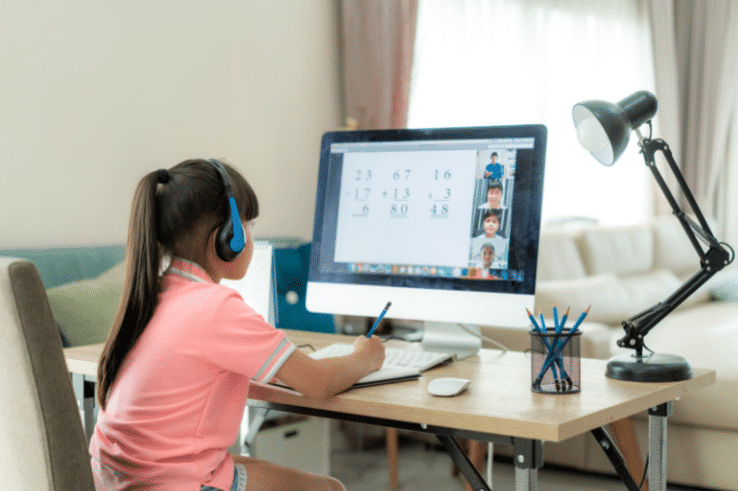
Jamie Turak is an Education Content Manager at Class. He's passionate about storytelling and helping to make education more accessible.

Jamie Turak is an Education Content Manager at Class. He's passionate about storytelling and helping to make education more accessible.

A diverse classroom has different learning styles because students learn best in different ways. And one learning style that works well for a particular student may not always feel accessible to another.
Designing lesson plans around the learning styles of various students poses an enduring challenge for educators, both in traditional and online classrooms. But the practice is essential to unique learning outcomes. And while schools grow distance learning enrollment and programs, previous iterations of virtual classrooms haven’t been dynamic enough for multisensory practices and pedagogy.
In online classrooms, students need multisensory instructional strategies–and new iterations of next-generation learning solutions can help. In this blog post, learn how enhanced virtual learning platforms serve students across the spectrum of senses. Get tips for bringing your virtual classroom to life to appeal to diverse sensory learning styles.
Multisensory learning engages senses, including linguistic, visual, auditory, and kinesthetic. The idea is to deliver lessons through the engagement of various senses to appeal to learners in different ways. Its benefits include
With the right tools and implementation strategies, educators can deliver multisensory instruction to a diverse student body, even in online classrooms.
Accessible multimedia content in various formats may be anchored on a single online platform. And then delivered to students individually or in groups with preferences for sensory learning styles. For this, personalization of content is critical to multisensory instruction online.
Modern virtual classrooms like Class.com offer enhanced breakout rooms, where instructors can launch unique content into each room and organize them by student preferences for learning style.
With personalization, virtual classrooms can amplify the impact of multisensory instruction. While virtual learning environments enable digital content sharing easily, they can also offer a more robust multisensory learning experience than traditional in-person classrooms if utilized correctly.
Let’s take a moment to review the most common sensory learning styles experienced by a diverse student body–and how you can bring them to life in your online classroom.
While most students prefer a singular learning style, some students may find two or more senses appealing. So identifying students’ learning preferences is crucial to success. And that means providing learning-style-adjusted content for students even on a case-by-case basis.
It’s also important to consider how a lesson or concept may be experienced. Learning, after all, is more than internalizing academic ideas. It’s a developmental process that shapes fundamental human aptitudes, including interpersonal, cognitive, and physical abilities, partly because humans evolved in multisensory contexts.
Linguistic learning denotes an affinity to use and engage with language. This means reading, writing, understanding, and speaking. Linguistic learning strategies often come in the form of discussion, writing exercises, and reading materials.
In an online classroom, engage linguistic learners with small-group discussions and declamation exercises. During a lesson, provide these learners opportunities to speak and exchange with each other–or ample time to read at their own pace.
Visual learners prefer images, graphics, and colors to map and communicate ideas and thoughts. These students must see information to learn it and may often have photographic memories.
Engage these learners online with images and color-coding exercises. Engaging photographs or video content can probe discussion and critical thinking or build memorable associations. Beyond media, brainstorm on a shared workspace–like Google’s Jamboards–to collaborate and color-code ideas and thoughts with sticky notes. Enable students to share screens with one another, so they can see what they’re working on in real time with peers.
Auditory learning means students learn best by listening. These students usually prefer listening to a recording over reading a textbook or hearing instructions for a lesson instead of figuring it out themselves. Instructional strategies that appeal to auditory learners engage music, chants, songs, soundbites, or audio playback of digital media content.
Your virtual classroom benefits these types of learners greatly. Use audio content from podcasts, videos, music, or sounds to keep students engaged and on track with your lesson.
Kinesthetic learning is when students learn best through physical manipulation or touch. Students with kinesthetic skills benefit from bringing a concept to life from a physical experience like writing. They are also deeply experiential and often learn best when they can figure something out for themselves – for example, taking apart something and putting it back together.
Even in online classrooms, you can support kinesthetic learners. For example, use a shared classroom whiteboard for these learners to take and scribble notes in real time. Or ask them to record videos of building or assembling things relevant to their lesson–and then report back to class.
Educators can incorporate a few routines to provide a better multisensory learning experience to remote K-12 students.
Class is an enhanced virtual learning platform that serves a variety of schools, levels, and institutions, including K-12 education. The Class K-12 design strategy is built with flexibility and choice, so students can more easily engage with the material online that works best for them and at their pace. At Class, we want to ensure your online classroom is truly inclusive for all students–no matter their unique needs, learning styles, or preferences.
Sign up for a demo today to learn how Class powers an online classroom that drives multisensory instruction to appeal to all the learning styles of your classroom.

Jamie Turak is an Education Content Manager at Class. He's passionate about storytelling and helping to make education more accessible.

Jamie Turak is an Education Content Manager at Class. He's passionate about storytelling and helping to make education more accessible.
Get our insights, tips, and best practices delivered to your inbox

Sign up for a product demo today to learn how Class’s virtual classroom powers digital transformation at your organization.

Features
Products
Integrations